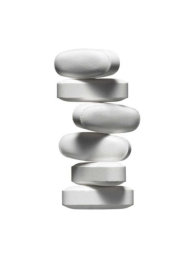
Aspirin is hailed as a miracle drug, and there's not a person among us who hasn't popped an ibuprofen or acetaminophen to deal with achy joints or a crushing headache.
But if you're doing that every day, you could be causing long-term damage to your health, says Gary Kaplan, DO, medical director of the Kaplan Center for Integrative Medicine and author of a new book called Total Recovery: Solving the Mystery of Chronic Pain and Depression.
"The biggest misconception people have about over-the-counter painkillers is that they're completely safe and harmless," says Dr. Kaplan. "They are neither of the above." In fact, most over-the-counter painkillers started out as prescription drugs but now are sold at lower doses without your needing to talk to a doctor.
And they're all bad in their own way. While Dr. Kaplan does contend that low doses of aspirin (81 milligrams) do have some benefits for people with risk factors for stroke, heart disease and some forms of cancer, larger doses taken daily to deal with the pains of daily living do not. "People pop these things like it's no big deal," he says. "If you do this every day, in the majority of people, you're doing real damage."
Before getting into what that damage is, it helps to understand how these medications work. Aspirin, ibuprofen (sold as Advil and Motrin), and naproxen sodium (sold as Aleve) all fall into a class of drugs called nonsteroidal anti-inflammatories, or NSAIDs. They work by inhibiting prostaglandin, a hormone that can produce pain and inflammation in response to an infection or injury. Acetaminophen (or Tylenol) falls into a different category and seems to interrupt the pain messages your brain receives.
#1: Gut ulcerations
NSAIDs, particularly ibuprofen and aspirin, are rough on your stomach, and they're just as rough on the lining of your gut. They create ulcerations and inflammation in the gut lining, damage that causes something known as a "leaky gut." When your gut is leaky, it doesn't absorb nutrients, which can lead to deficiencies (which can also contribute to pain problems), and problematic proteins and allergens, such as gluten, soy, or egg proteins, can escape, triggering food sensitivities. "Your gut is a very sophisticated filter," Dr. Kaplan says. "It's a very complex organ that's not one to disrupt, but one that we disrupt all the time."
Furthermore, NSAIDs disrupt the gut bacteria that control your immune system. As a result, you get sick more frequently and you might develop more chronic ailments.
Sixty to 80 percent of people develop gut inflammation within 24 hours of taking an NSAID, Dr. Kaplan says, and 50 to 70 percent of people who take them long term will develop chronic small intestine inflammation. And initially that might present as just feelings of bloating, gas or changes in your bowel movements, but over time, you might start experiencing chronic fatigue or develop food intolerances.
#2: Liver damage
Acetaminophen doesn't cause those gut ulcerations, Dr. Kaplan says. Rather, its problem is that it will damage your liver--sometimes, in unexpected ways. Things like alcohol can interfere with the way your body breaks down acetaminophen, even if you're taking a normal dose. "That leads to the potential to get a toxic level of acetaminophen in your system, which leads to liver damage," Dr. Kaplan says. He's also found that taking too many painkillers that contain caffeine can stress out your liver and interfere with sleep.
#3: Kidney damage
Along with your stomach, your kidneys are a major production site of prostaglandins, the hormones that NSAIDs are designed to silence. In addition to controlling the acid secretions in your stomach, prostaglandins help the kidneys fulfill their function of removing proteins and waste from your blood. Too many prostaglandin-inhibiting NSAIDs can interfere with that process, leading to kidney damage and a buildup of toxic waste by-products in your bloodstream. "As soon as we start seeing damage to kidneys, we tell people to get off all anti-inflammatory medications," Dr. Kaplan says.
Furthermore, prostaglandin produces inflammation in response to damage your body is experiencing. "Inflammation is not always a bad thing," he adds. "It's critical for repair--inflammation cleans up damaged tissue and brings in new cells to repair it. When inflammation gets disrupted, the normal healing process gets disrupted."
#4: Heart disease
You may remember a prescription painkiller called Vioxx that was pulled from the market a few years ago. The reason? It caused heart attacks, and it's not the only one. "It's a lower risk than with Vioxx, but all NSAIDs pose a risk," says Dr. Kaplan. NSAIDs block an enzyme called COX-2, which works with prostaglandin to protect your arteries. When both are silenced by chronic use of over-the-counter painkilllers, your risk of heart disease increases.
#5: Hypersensitization
Here's an ironic fact: Painkillers can heighten your susceptibility to pain. While this phenomenon has been seen mostly with prescription opiods (such as Vicodin or Oxycontin), studies have shown that acetaminophen and NSAIDs can have the same effect on headaches. "It's called a rebound headache," Dr. Kaplan says. "They dull your response to pain, so you need more medications to get to the same place. And you end up developing increased sensitivity to pain."
So are we all supposed to just grin and bear it if we have a headache or a sore knee? "The occasional use is fine, less than once a week," Dr. Kaplan advises. "But if you have pain that requires that you take over-the-counter pain medication on a regular basis, you need to seek medical attention."
Ultimately, Dr. Kaplan's beef with painkillers is that they aren't dealing with deeper health issues. "Doctors have to start looking at pain as a symptom and not the disease," he says. "We're better off addressing the problem. We need to understand where the pain is coming from."
Original article at:
By Emily Main, Rodalenews.com
By Emily Main, Rodalenews.com
By Emily Main, Rodalenews.com
